LOS SITIOS
DEL AGUA, NORTHERN SONORA
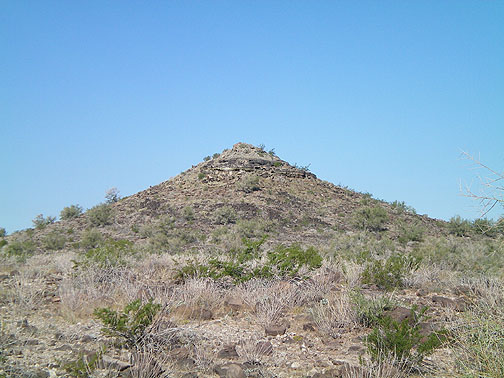
The vent and dome at Los Sitios del Agua
Based on a 1992 analysis of 71 obsidian
artifacts from various sites located in Organ Pipe Cactus National Monument,
Steve Shackley noted 10 artifacts that exhibited an elemental chemistry
different from any yet identified in the Southwest (Shackley 1992, 2005).
Since then, this unlocated source called AZ Unknown A, has been found in
archaeological sites of various age throughout southern Arizona, as far
north as the Phoenix Basin (Shackley 2005; Shackley and Tucker 2001).
While exploring Historic era trails in northwestern Sonora, Mexico, members
of the Ajo Chapter of the Arizona Archaeological Society discovered a
previously unknown source of obsidian and other archaeological sites
adjacent to the Rio Sonoyta in northern Sonora (Figure 1). This newly
discovered source, called Los Sitios del Agua, is AZ Unknown A and finally
locates this most vexing unknown obsidian sources in the region and provides
important source provenance data for the Archaic through Historic periods in
the southern Southwest.
THE DISCOVERY
During
the spring of 2006, several members of the Ajo Chapter of the Arizona
Archaeological Society were exploring back roads in northwestern Sonora,
Mexico. After emerging onto a wide flat terrace immediately above the
floodplain of the Rio Sonoyta, nodules of obsidian were observed among the
gravels covering the terrace. During a return visit in the fall of 2006, an
obsidian quarry was discovered in the hills at the northern edge of this
same terrace. Based on the results of a trace element analysis of two
samples conducted by the Northwest Research Obsidian Studies Laboratory in
Corvallis, Oregon it is known that the characteristics of this obsidian
(Table 1) are the same as those from Los Vidrios Obsidian Quarry (LV)
(Skinner 2007a) as originally reported by Shackley (1988, 1995, 2005).
In the spring
of 2007, exploration along the banks of the Rio Sonoyta approximately 8-9 km
downstream from the LV quarry revealed obsidian marekanites littering the
sides of a rhyolite dome complex. The trace element characteristics of four
samples of this obsidian (Table 1) did not match those from LV, but instead
were the same as those classified as “Unknown 1" by Skinner (2007a, 2007c)
and as AZ Unknown A discovered by Shackley (1992, 1995, 2005). The obsidian
source for these samples previously known as Unknown 1 and AZ Unknown A has
now been located and will be named the Los Sitios del Agua Obsidian Quarry (LSA).
In October 2008 Rick and Sandy Martynec and Steve Shackley re-visited the
rhyolite dome complex for two days, recorded and mapped the LSA source
again, and collected over 300 marekanite samples for study at Berkeley.
While it is
considered part of the same volcanic field as Los Vidrios, the composition,
that of a mildly peralkaline rhyolite, is quite different (Vidal-Solano et
al. 2008; see
http://swxrflab.net/los_sitios_del_agua.htm). The rhyolite dome is also
called Vidrios Viejos and as mentioned above has an 40Ar/39Ar
date of 14.27±0.15 Ma statistically similar to Los Vidrios (Vidal-Solano
et al. 2008:697.
THE
OBSIDIAN AT LOS SITIOS DEL AGUA
Los Sitios del
Agua is a probable Tertiary Period dome complex oriented in a
northwest-southeast arc (see Fig. 2). Typical of Tertiary rhyolite dome
complexes that produce obsidian, Los Sitios del Agua exhibits perlitic lava
bodies with abundant remnant marekanites, some as large as seven to eight
centimeters, and many near five centimeters (Shackley 2005; Fig. 3 here).
As with Los
Vidrios, the Los Sitios del Agua domes appear to be part of a bimodal
volcanic field known as the Sierra Pinacate Volcanic Field that consists of
initial Tertiary events, mainly rhyolite in composition followed by mainly
mafic eruptive events to the west of the earlier rhyolite during the
Quaternary including 10 maar volcanic events (Donnelly 1974; Gutmann 2007;
Gutmann et al. 2000). Virtually no geological research has been
directed toward the rhyolite on the eastern portion of the volcanic field
other than the initial work by Shackley (1988, 1995, 2005).
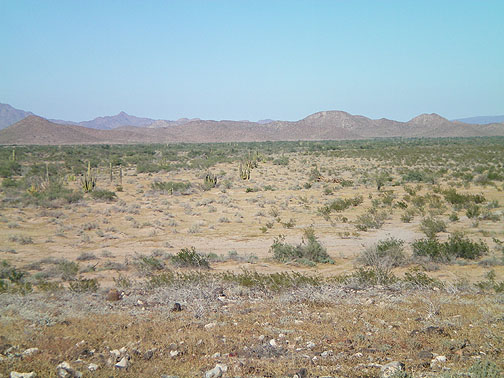
The Los Vidrios dome complex west of Los Sitios del Agua
The majority
of obsidian at the LSA quarry does not appear to have been formed in the
same manner as that at Los Vidrios. Virtually all of the LSA marekanites are
remnant marekanites in perlitic lava. None of the marekanites were
produced by ash flows as in the Los Vidrios case (Shackley 1988; Figure 3
here). In addition to the angular quality of the obsidian from the LSA
quarry, there are color variations within the site. Scattered about and
localized in at least one area are light grey marekanites of obsidian.
Even more startling is a small quarry near the center of the LSA quarry
where beautiful, jade green colored obsidian was apparently mined based on
what appears to be a small prospect; this green obsidian has been termed
Kate’s Green after its discoverer. When tested by Skinner (2007c) this
green obsidian was found to have nearly the same trace element composition
as the surrounding jet black obsidian. Analysis of source standards
here in the Berkeley lab indicates substantive differences in barium in the
green samples, however (Tables 2 and 3). The other measured elements
are similar (Table 3). It is obvious that this unique colored obsidian
held a special appeal. It still does today.
The other measured
elements are similar. It is obvious that this unique colored obsidian held
a special appeal. It still does today. The composition as reported by
Vidal-Solano et al. using plasma-atomic emission spectroscopy matches well
with the EDXRF data from this lab (2008:695).
SOURCE DESCRIPTION
Although most of the surface obsidian at the LSA quarry exhibits a shiny,
almost freshly broken appearance, only a few lithic reduction stations were
noted. While examination of the site revealed scattered reduction flakes and
cores, there are a few locations where numerous nodules have been tested by
the bipolar reduction method. Here amongst the layers of debitage can
be found large, thin primary flakes, some are quite long exceeding 5 cm in
length. This undoubtedly was a characteristic desired for the production of
the small, delicately made projectile points and cutting and scraping tools
found on nearby sites. One is led to conclude from the lack of secondary and
final pressure flaking debitage at the LSA quarry, that the larger and more
desirable flakes were transported to other locations for further and final
refinement. Knapping experiments by Shackley noted that LSA obsidian is
considerably less brittle than the nearby Los Vidrios obsidian that occurs
in much larger quantities. Production of a Desert Side-notched
projectile point from the production of a bipolar flake took less than 20
minutes with excellent predictability. As discussed below, this may be
why Los Sitios del Agua is common in archaeological contexts to the north
even though the source material is numerically inferior to Los Vidrios.
Physically, the obsidian at the LSA quarry encompasses an area that measures
approximately 800 meters north-south by 850 meters east-west; the base of
the small hills are at 207 meters above sea level and rise to an elevation
of 224 meters above sea level. The density of obsidian on the ground surface
varies widely within the quarry from areas where there are no nodules to
others where there are more than 500 in one square meter. There
appears to be virtually no secondary deposition into the Rio Sonoyta, at
least as evident today. This may be why it was not discovered by the
earlier study in the 1980s (Shackley 1988).
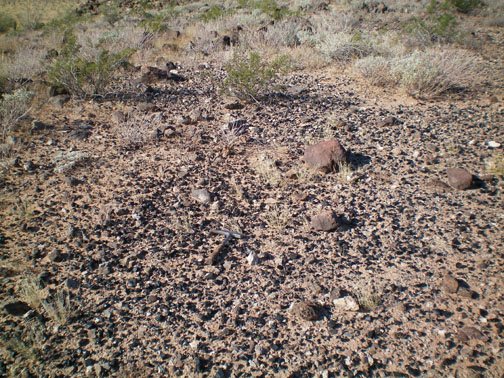
The high surface density of marekanites
at Los Sitios del Agua
XRF ANALYSIS
Of over 300 marekanite
samples collected from Los Sitios del Agua, 40 samples (»
13%) were analyzed by energy-dispersive x-ray fluorescence spectrometry for
16 elements, ten of which are reported here (Tables 2 and 3). The
laboratory and instrument protocol is here (see also
Shackley et al. 2016).
Immediately apparent is that
this rhyolite lava is a mildly peralkaline rock. These volcanic rocks are
generally seen as a division of volcanics where the proportion of alumina
(AlO2) is less than that of sodium and potassium oxides combined,
but more importantly generally exhibits relatively high iron and zirconium
values (Best 1982; Cann 1983; Hildreth 1981; Shackley 2005; see Figure 4
here). These peralkaline volcanic rocks, including rhyolitic obsidian is
common in rift regions were more mafic lava associated with the mantle is
sampled and crustal volcanism occurs, such as the Great Rift Valley in
eastern Africa. In the Rio Sonoyta case, the elemental composition of Los
Vidrios and Los Sitios del Agua couldn’t be more different (Figure 4).
There are no peralkaline obsidians north of the International border, but
are quite common associated with the Sierra Madre Occidental, probably the
largest rhyolite field in the world, and the Chihuahuan Basin and Range
just to the east of the Sierra of eastern Sonora and Chihuahua. (Gunderson
et. al. 1986; Fralick et al. 1998; Shackley 2005). In obsidian, peralkaline
chemistry is objectified by very dark often opaque glass, and glass that is
often green when viewed with transmitted light both caused by a high iron
content. The most archaeologically famous peralkaline glass in the New
World is that from Sierra de Pachuca, in the state of Hidalgo, Mexico
(Barker et al. 2002; Tenoria 1998). The obsidian from Los Sitios del Agua
Areas A, B, C, and E, are all translucent dark green similar to Pachuca,
while the marekanites from Area D is an opaque light green - all due to the
relatively high iron. This makes Los Sitios del Agua obsidian the most
megascopically distinct of the Sonoran Desert obsidian sources.
LOS SITIOS DEL AGUA IN SITES NORTH OF THE BORDER
Besides the
ten artifacts analyzed by Shackley from Organ Pipe Cactus National Monument
just north of the border, obsidian from Los Sitios del Agua has also been
recorded (as AZ Unknown A) in other sites as far north as the Phoenix
Basin. Table 4 exhibits the number of artifacts produced from Los Sitios
del Agua in Arizona sites. The vast majority of Los Sitios del Agua
obsidian is from sites in southern Arizona, including sites in the Phoenix
Basin. It is almost always in assemblages where Los Vidrios obsidian also
occurs, suggesting that marekanites from both sources were collected
prehistorically together while traveling along the Rio Sonoyta as discussed
above. It was not found at the Preclassic site of Snaketown on the Gila
River Indian Nation, but a few were recovered from surface sites on the Gila
River Indian Nation (Shackley 2005; Table 4 here). It also was not
recovered from the Classic Period sites of Pueblo Grande or Casa Grande (Bayman
and Shackley 1999; Peterson et al. 1997).
CONCLUSION
The discovery of the Los
Sitios del Agua obsidian source in northern Sonora solves one of the unlocated sources in the Southwest. The glass proper, a green peralkaline
obsidian, is unique in the Sonoran Desert for its color and just as unique
chemically, and probably held value in prehistory. Los Sitios del Agua is a
small dome complex covering a much smaller area than the extensive dome
complex of Los Vidrios, mostly across the Rio Sonoyta. It does, however,
occur in sites at least as far north as the Phoenix Basin and often in
association with artifacts produced from Los Vidrios obsidian. While these
two Sonoyta River Valley obsidian sources were likely sampled by groups
moving north or south through the area, it is not necessarily clear whether
they can be used as a signature of shell exchange during any particular time
period. Reconnaissance of the valley by members of the Arizona
Archaeological Society suggests that all time periods, particularly
Preclassic through Historic periods are represented at sites in the region.
To References
Table 1. Results of previous XRF Studies modified to include new
findings (mean values)
|
|
|
Trace Element Concentrations1 |
Ratios |
|
|
Quarry Site |
Zn |
Pb |
Rb |
Sr |
Y |
Zr |
Nb |
Ti |
Mn |
Ba |
Fe2O3 |
Fe:Mn |
Fe:Ti |
|
Los Vidrios (Skinner 2007a) |
82 |
28 |
258 |
14 |
67 |
216 |
28 |
445 |
178 |
16 |
1.29 |
62.8 |
93.9 |
|
Los
Vidrios (Shackley 1995) |
n.r.2 |
n.r. |
260 |
14 |
75 |
235 |
32 |
784 |
208 |
82 |
1.31 |
n.r |
n.r. |
|
Unknown 1 (Skinner 2007a)
Los Sitios del Agua (LSA) |
113 |
25 |
140 |
15 |
83 |
691 |
47 |
1092 |
444 |
33 |
3.24 |
60.1 |
97.0 |
|
AZ
Unknown A (Shackley 1992, 1995, 2005) |
n.r. |
n.r |
141 |
18 |
79 |
713 |
47 |
2265 |
566 |
n.r |
n.r |
n.r |
n.r |
1
All trace element values reported in parts per million |
|
2
n.r. = no report |
|
|
To the raw elemental data
Table 2. Mean and central
tendency for elemental concentrations for the Los Sitios del Agua source
standards for Localities A, B, C, and E source standards analyzed at Berkeley.
All measurements in parts per million (ppm).
|
|
Ti |
Mn |
Fe |
Zn |
Rb |
Sr |
Y |
Zr |
Nb |
Ba |
|
N |
|
36 |
36 |
36 |
36 |
36 |
36 |
36 |
36 |
36 |
34 |
|
Mean |
1261 |
543 |
25821 |
148 |
143 |
12 |
81 |
724 |
48 |
121 |
|
Std.
Error of Mean |
16 |
38 |
335 |
2 |
1 |
0 |
1 |
3 |
1 |
2 |
|
Std.
Deviation |
94 |
230 |
2008 |
11 |
7 |
2 |
3 |
20 |
3 |
13 |
|
Minimum |
1052 |
384 |
20158 |
127 |
126 |
10 |
72 |
666 |
40 |
93 |
|
Maximum |
1455 |
1727 |
29443 |
170 |
156 |
17 |
88 |
762 |
56 |
142 |
Table 3. Mean
and central tendency for Los Sitios del Agua for Locality D (green marekanites)
source standards analyzed at Berkeley (note barium values versus data in Table
2). All measurements in parts per million (ppm).

Table 4. Number
of artifacts produced from Los Sitios del Agua in various sites in Arizona
analyzed at Berkeley as of 2008.
|
|
|
Site or
Project |
Number
of LSA samples |
Reference |
|
Organ
Pipe Cactus Nat. Monument |
10 |
Shackley 1992 |
|
Gila
River Indian Nation (surface survey) |
4 |
Shackley 2004, 2006 |
|
Tumacacori Nat. Hist. Park |
2 |
Shackley 2008a |
|
Ajo
Sites (BLM) |
5 |
Shackley 2008b |
|
Cabeza
Prieta Nat. Wildlife Refuge |
10 |
Shackley 2008c |
|
Tohono
O'odahm Nation |
2 |
Shackley 2008d |
|
|
|
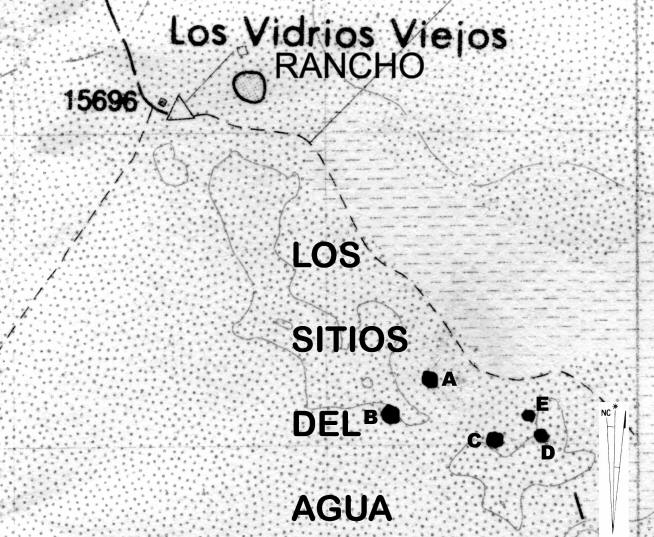
Figure 2. The
Los Sitios del Agua dome complex and surrounding features. Letters denote
collection areas recorded, analyzed, and discussed in text (see Table 1).
Rancho Los Vidrios Viejos is that structure mentioned in Shackley (1988) from
the 1985 survey. Marker 15696 is the INEGI, Mexico federal marker. Grid is
1000 meters, declination is 13º 15' in 1981, adapted from the El Papalote
(H12A13) Sonora/Arizona sheet, INEGI, Mexico.
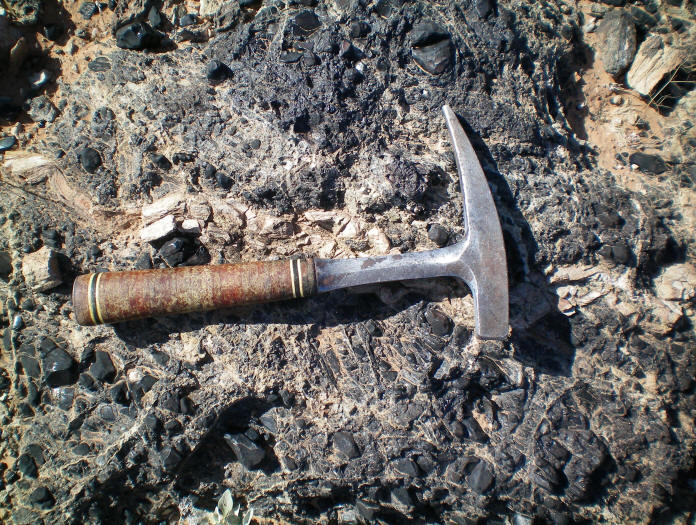
Figure 3.
Marekanite remnants in perlitic lava at Area B, Los Sitios del Agua.

Figure 4. Rb
versus Zr biplot of source standards from Los Sitios del Agua and Los Vidrios,
Sonora. Measurements in parts per million (ppm).


Figure 5. Zr
versus Rb, and Ba versus Zr of the Los Sitios del Agua source standards.
Note the higher Ba in Area D samples. The other sample areas are very
similar in the other two elements selected.
References
Barker, A.W., C.E. Skinner, M.S. Shackley, M.D. Glascock, and
J.D. Rogers
2002 Mesoamerican Origin
for an Obsidian Scraper from the Precolumbian Southeastern United States.
American Antiquity 67:103-108.
Bayman, J. M. and M. S. Shackley
1999 Dynamics of Hohokam
Obsidian Circulation in the North American Southwest. Antiquity
73:836-845.
Best, M.G.
1982 Igneous and
Metamorphic Petrology. W.H. Freeman, New York.
Cann, J.R.
1983 Petrology of Obsidian Artefacts. In
The Petrology of Archaeological Artefacts, edited by D.R.C. Kempe and A.P.
Harvey, pp. 227-255. Clarendon Press, Oxford.
Davis, M.K., T.L. Jackson, M.S.
Shackley, T. Teague, and J. Hampel
1998 Factors Affecting the Energy-Dispersive X-Ray Fluorescence (EDXRF)
Analysis of Archaeological Obsidian. In Archaeological Obsidian Studies:
Method and Theory, edited by M.S. Shackley, pp. 159-180. Springer/Plenum
Press, New York.
Fralick, P.W.,
J.D. Stewart, and A.C. MacWilliams
1998 Geochemistry of
West-Central Chihuahua Obsidian Nodules and Implications for the Derivation of
Obsidian Artefacts. Journal of Archaeological Science 25:1023-1038.
Gunderson, R., K. Cameron,
and M. Cameron
1986 Cenozoic High-K
Calc-Alkalic and Alkalic Volcanism in Eastern Chihuahua, Mexico: Geology and
Geochemistry of the Benevides-Pozos Area. Geological Society of America
Bulletin 97:737-753.
Hildreth, W.
1981 Gradients in Silicic
Magma Chambers: Implications for Lithospheric Magmatism. Journal of
Geophysical Research 86:10153-10192.
Peterson, J., D.R. Mitchell,
and M.S. Shackley
1997 The Social and
Economic Contexts of Lithic Procurement: Obsidian from Classic Period Hohokam
Sites. American Antiquity 62:231-259.
Shackley, M. Steven
1988 Sources of
Archaeological Obsidian in the Southwest: An Archaeological, Petrological, and
Geochemical Study. American Antiquity 53:752-772.
1990 Early Hunter-Gatherer Procurement Ranges in the Southwest: Evidence
from Obsidian Geochemistry and Lithic Technology. Ph.D. dissertation,
Arizona State University, Tempe.
1992 An Energy Dispersive X-ray Fluorescence
(EDXRF) Analysis of 71 Obsidian Artifacts from Organ Pipe Cactus National
Monument, Southern Arizona. Ms. on file with the National Park Service,
Western Archaeological and Conservation Center, Tucson.
1995 Sources of
Archaeological Obsidian in the Greater American Southwest: An Update and
Quantitative Analysis. American Antiquity 60(3):531-551.
2004 Source Provenance of Obsidian Artifacts from Various Contexts on the
Gila River Indian Community Land, Central Arizona. Report Prepared for the Gila
River Indian Nation.
2005 Obsidian: Geology and Archaeology in the North American Southwest.
University of Arizona Press. Tucson.
2006 Source Provenance of Obsidian Artifacts from Various Contexts on the
Gila River Indian Community Land, Central Arizona II. Report Prepared for the
Gila River Indian Nation.
2008a Source Provenance of Obsidian Artifacts from Tumácacori National Historic
Park, Southern Arizona. Report prepared for Tumácacori National Historic Park,
Arizona.
2008b Source Provenance of Obsidian Artifacts from Archaeological Sites South
of Ajo, Arizona. Report prepared for the Bureau of Land Management, Lower
Sonoran Field Office, Phoenix, Arizona.
2008c Source Provenance of Obsidian Artifacts from the International Border,
Cabeza Prieta National Wildlife Refuge and Wilderness, Southern Arizona. Report
prepared for Northland Research, Inc., Tempe, Arizona.
2008d Source Provenance of Obsidian Artifacts from the International Border,
Tohono O’odahm Nation, Southern Arizona. Report prepared for Northland
Research, Inc., Tempe, Arizona.
Shackley, M.S., F. Goff, and S.G. Dolan
2016 Geologic origin of the source of Bearhead rhyolite (Paliza Canyon)
obsidian, Jemez Mountains, Northern New Mexico. New Mexico Geology 38:52-62.
Skinner, Craig E.
2007a X-Ray Fluorescence
Analysis of Artifact Obsidian from Sonora B:4:503, Sonora B:4:511a, and Sonora
B:4:511b, Sonora, Mexico. Report 2007-41 prepared for the Ajo Chapter of the
Arizona Archaeological Society, Ajo, Arizona, by Northwest Research Obsidian
Studies Laboratory, Corvallis, Oregon.
2007b X-Ray Fluorescence
Analysis of Artifact Obsidian from AZ Z:9:46 (ASM), AZ Z:9:52 (ASM), and AZ
Z:9:73 (ASM), Pima County, Arizona. Report 2007-95 prepared for the Ajo Chapter
of the Arizona Archaeological Society, Ajo, Arizona, by Northwest Research
Obsidian Studies Laboratory, Corvallis, Oregon.
2007c X-Ray Fluorescence
Analysis of Artifact Obsidian from Sonora B:4:511, Sonora B:4:513, and Sonora
B:4:516, Sonora, Mexico. Report 2007-124 prepared for the Ajo Chapter of the
Arizona Archaeological Society, Ajo, Arizona, by Northwest Research Obsidian
Studies Laboratory, Corvallis, Oregon.
Sliva, R. Jane
1997. Introduction to the
Study and Analysis of Flaked stone Artifacts and Lithic Technology. Center
for Desert Archaeology. Tucson.
Tenoria, D., A. Cabral, P. Bosch,
J. Jiménez-Reyes, and S. Bulbulian
1998 Differences in Coloured Obsidians from Sierra de Pachuca, Mexico.
Journal of Archaeological Science 25:229-234.
This page maintained by Steve Shackley

Copyright © 2018 M. Steven
Shackley. All rights reserved.
Revised: 22 August 2024
 Back to
the SW obsidian source page.
Back to
the SW obsidian source page.
 To the EDXRF Lab home page
To the EDXRF Lab home page








